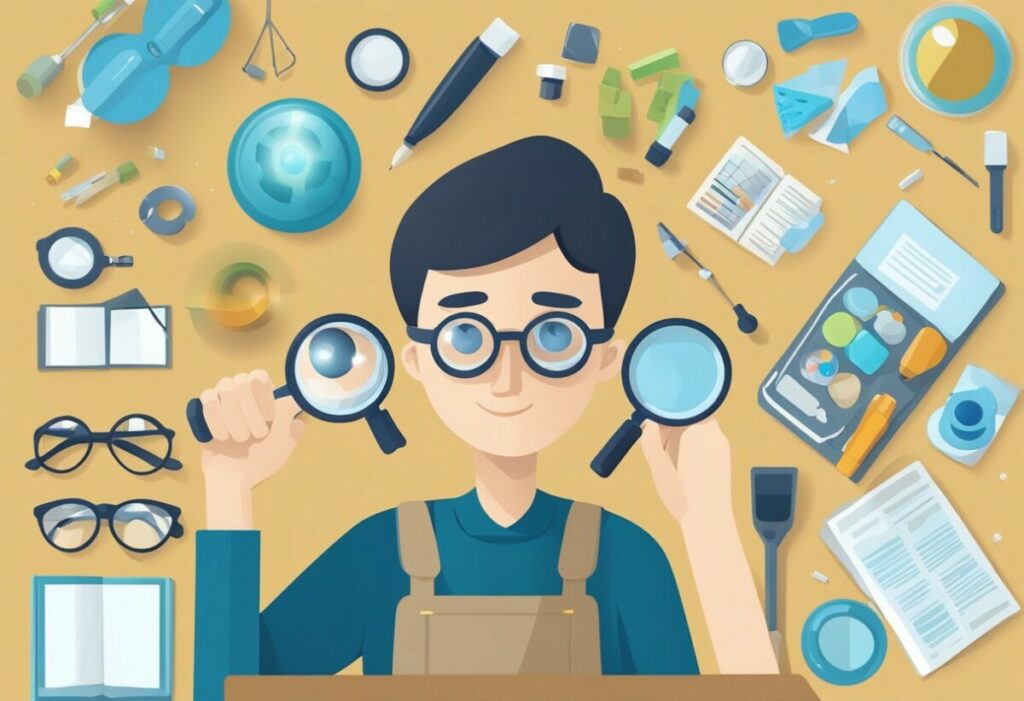Prioritizing Eye Health: Practical Advice for Managing Low Vision

Maintaining eye health is essential for ensuring a high quality of life, particularly for individuals managing low vision. Vision loss can deeply impact one’s sense of independence, but with awareness and proper management, people living with low vision can lead fulfilling lives. March, observed as Eye Care Awareness Month, serves as a vital reminder for the importance of comprehensive eye exams and eye health vigilance. We at New England Low Vision and Blindness underscore this message, highlighting the significance of prioritizing eye care and taking proactive steps to protect and enhance vision.
We understand the challenges that come with low vision and how it can affect daily activities. As a leading provider of assistive technology and training for people with vision impairments, we are committed to bringing hope and practical solutions to those affected. By leveraging leading-edge technology, we facilitate individuals in reclaiming their independence and participating more fully in their chosen lifestyles. By focusing on eye health and taking preventative measures against vision issues, everyone has the potential to enjoy a more vibrant, independent life, regardless of visual limitations.
Understanding Low Vision and Its Causes
In recognition of March Eye Care Awareness Month, we emphasize the significance of understanding low vision, its various types, and the most common conditions that lead to it. Proper knowledge and early detection through comprehensive eye exams can greatly impact one’s eye health.
Types of Vision Impairment
Vision impairment can range from mild to severe, where individuals may experience central vision loss affecting their ability to see straight ahead, or peripheral vision loss, which can remove the edges of their visual field. Low vision is the condition where a person’s visual acuity is 20/70 or lower, and cannot be corrected to normal vision.
Common Eye Conditions Leading to Low Vision
Several eye conditions can result in low vision; among them, age-related macular degeneration (AMD) is a leading cause, affecting the retina and potentially causing significant central vision loss. Other prevalent conditions include glaucoma, which can damage the optic nerve, and cataracts, which cloud the lens of the eye. These conditions are frequently irreversible and can result in varying levels of vision loss.
The Impact of Aging on Eye Health
Aging is one of the most significant risk factors for developing eye conditions that can lead to low vision. As we age, the likelihood of conditions like AMD, glaucoma, and cataracts increases. Therefore, maintaining an awareness of changes in vision and regular eye examinations play a critical role in detecting eye health issues early and managing them with leading-edge assistive technology and training from specialists like us at New England Low Vision and Blindness, to enhance quality of life.
The Importance of Regular Eye Examinations
Maintaining eye health is pivotal, and regular eye examinations are a core component of vision care, especially for individuals with low vision. These exams are crucial for spotting any changes in vision and addressing them promptly.
Comprehensive Eye Exam Procedures
During a comprehensive eye exam, our skilled ophthalmologists conduct a thorough assessment of your eyesight and eye health. The exam typically begins with a review of your medical history to understand any vision problems or health conditions that could affect your eyesight. Key components of the exam include:
- Visual Acuity Test: This measures how well you see at various distances.
- Dilated Eye Exam: We administer special drops to dilate your pupils. This allows the eye doctor to examine the retina and optic nerve for signs of damage.
- Glare and Light Sensitivity Test: Particularly important for low vision patients, this test evaluates how your eyes respond to bright lights and varying levels of illumination.
Detecting Vision Problems Early
Identifying potential vision problems early on is beneficial for managing conditions that could lead to further vision impairment. Here’s why early detection is important:
- Unnoticeable Symptoms: Some eye diseases, such as glaucoma, often don’t present noticeable symptoms until the advanced stages. Regular eye exams are essential for early intervention.
- Changes in Vision: By monitoring your vision frequently, we can detect subtle changes that may not be immediately apparent to you, facilitating early treatment that can prevent deterioration.
By prioritizing regular comprehensive eye exams, especially during March Eye Care Awareness Month, you invest in the long-term health of your eyes. Our commitment is to bring hope and leading-edge solutions for those with vision challenges.
Treatment Options and Management
When an individual is diagnosed with low vision, understanding the available treatment options and management strategies is key. We aim to provide clarity on these options to better manage eye health and maintain independence.
Medical and Surgical Treatments
Medical and surgical treatments are primarily conducted to address the underlying causes of low vision. For conditions like macular disease, specific medical treatments may be recommended to slow the progression or potentially regain a degree of vision. Surgical treatment could also be an option for certain eye health issues, such as cataracts, which may restore vision to some extent or prevent further decline. Each treatment plan is as unique as the individual receiving it and will depend on the specific diagnosis and progression of their condition.
Vision Rehabilitation Services
Vision rehabilitation services play a pivotal role in empowering individuals to live well with low vision. Through vision rehabilitation, patients learn to use their remaining vision effectively with the aid of leading-edge assistive technology. Our team offers a variety of low vision resources, from magnification devices to adaptive technology training, customized to each person’s needs. Our goal is to bring hope and practical support to individuals with permanent vision loss, ensuring they have the tools and skills to maximize their independence.
March is Eye Care Awareness Month, and we emphasize the importance of regular and comprehensive eye exams. Early detection of eye health issues can lead to better outcomes, and when treatments are no longer viable, our commitment is to guide our clients through an adaptive journey to restore confidence and function.
Living with Low Vision: Tools and Adaptations
Adapting to low vision often involves incorporating specialized tools and making adjustments to your environment. We understand that enhancing visual capability and ensuring safety are crucial for maintaining independence.
Aids and Devices to Enhance Vision
Glasses and Contact Lenses: Eyeglasses or contact lenses prescribed specifically for low vision can significantly improve visual acuity. We provide recommendations for the most suitable lenses that enhance clarity and reduce glare.
Magnifying Glasses: Handheld or stand magnifiers are essential for tasks like reading. Some devices offer built-in lighting to aid with contrast and visibility.
High-Tech Devices: Technologies like electronic magnifiers and text-to-speech tools empower individuals to read and engage in everyday activities with greater ease.
Sunglasses with Anti-Glare: To reduce glare and increase comfort outdoors, anti-glare sunglasses can be very helpful, especially for those with heightened light sensitivity.
Home Modifications for Safety and Accessibility
Lighting: Improving lighting around the home is vital. Installing brighter lights with adequate wattage can enhance visibility, especially in areas like stairwells and hallways.
Contrast: Enhancing contrast can make a huge difference. This can include painting doorknobs a different color than doors or using labeling systems for quick identification.
Smart Home Devices: Leveraging smart home devices to control lighting, read aloud the time, or remind when to change smoke detector batteries can bolster safety and autonomy.
Safety Features: Installing safety bumpers, safety bars, and ensuring that flooring is non-slip can prevent falls and injuries around the house.
At New England Low Vision and Blindness, our commitment during March Eye Care Awareness Month is to equip those with visual impairment with leading-edge low vision resources and technologies. Through our expertise as a trainer for assistive technology, we aim to ensure that you live a safe and independent life, full of hope and possibility.
Accessing Support and Resources
In recognition of March Eye Care Awareness Month, we emphasize the substantial difference access to proper support and resources can make for individuals with low vision. It’s our goal to illuminate pathways to independent living and highlight organizations that can significantly enhance the lives of those impacted by visual impairments.
Organizations Dedicated to Low Vision
There are numerous organizations that work tirelessly to support individuals with low vision. One such organization is the American Printing House for the Blind, which provides a directory of services. The Glaucoma Research Foundation also plays a pivotal role in offering resources and support to those affected by glaucoma. Moreover, we at New England Low Vision and Blindness, provide leading-edge assistive technology and training to facilitate independent living and enhance quality of life.
Improving Daily Life Through Support
Support extends beyond organizations; it’s about making practical adjustments to enhance lifestyle and independence. For instance, altering the home environment to reduce clutter and secure area rugs can minimize hazards. It’s prudent to arrange furniture in a way that maximizes mobility and safety. Incorporating contrasting colors can greatly improve navigation and the use of space in the home. Providing resources in both English and Spanish, the Centers for Disease Control and Prevention emphasizes the significant impact that vision rehabilitation services have on the lives of individuals with low vision.






